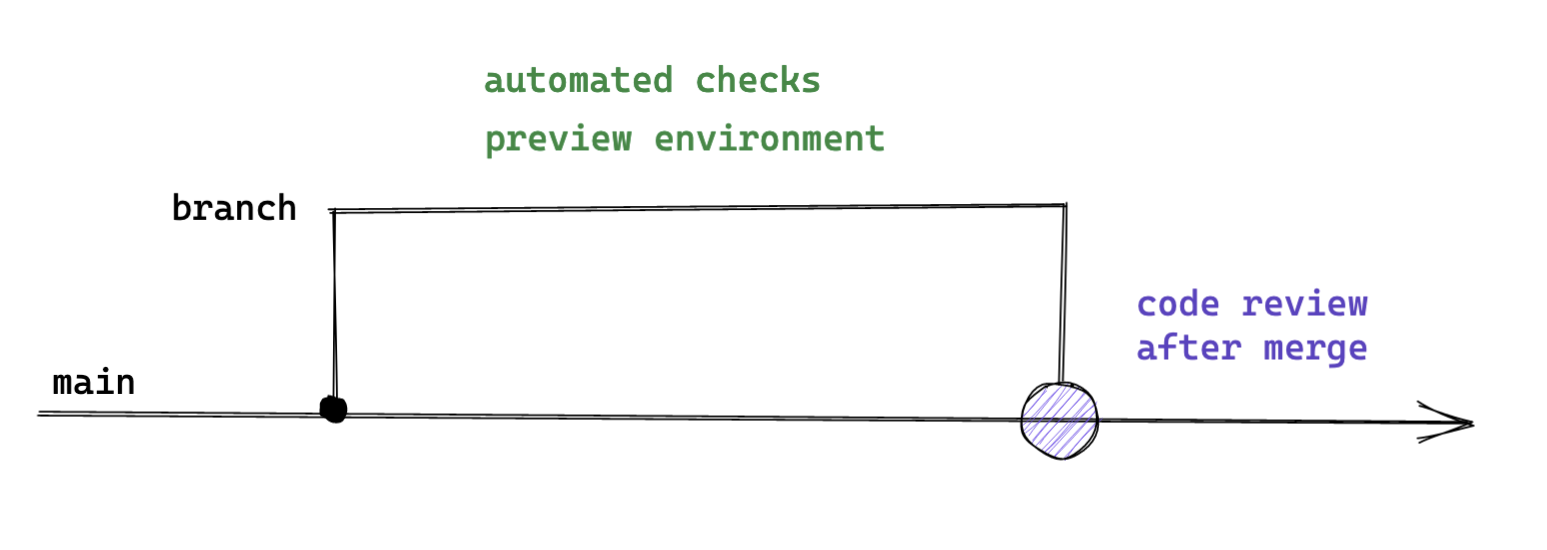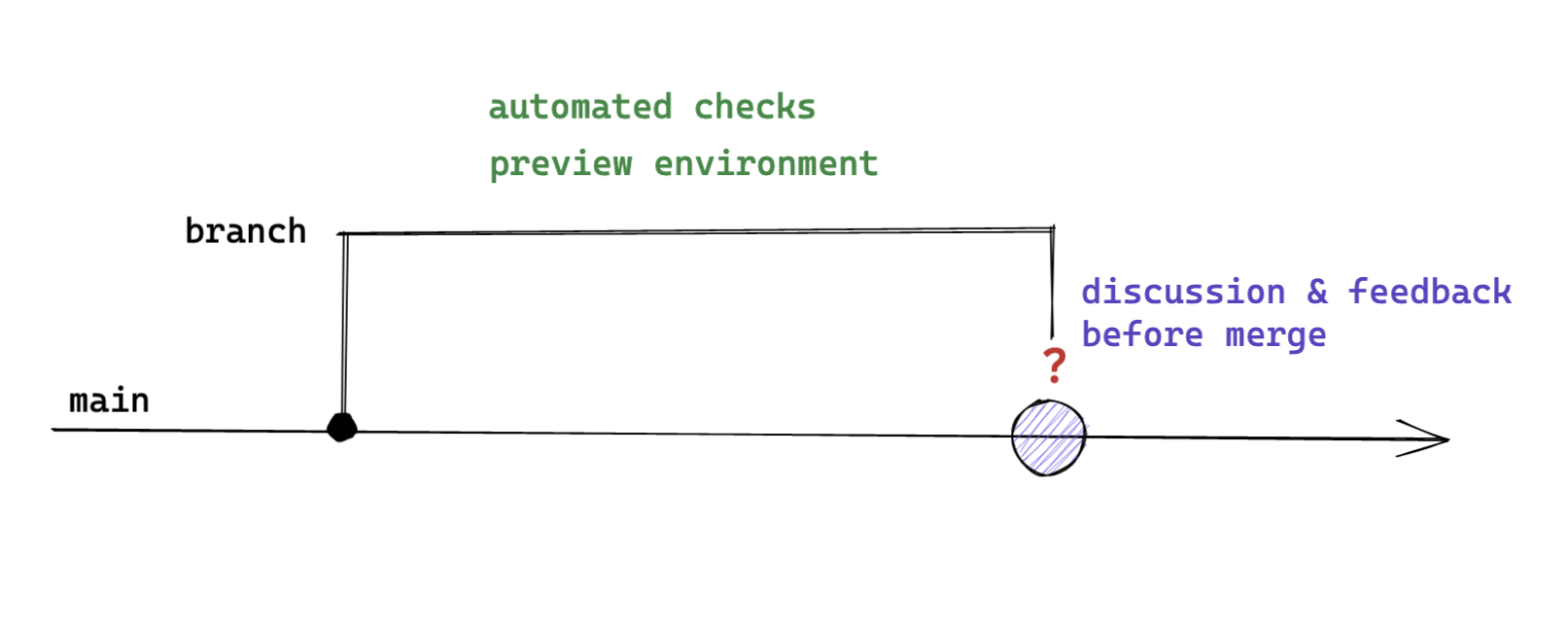[ad_1]
How do you do Steady Integration with Pull Requests?
Pull Requests have been extensively adopted by many software program groups. Some
individuals love them, and a few individuals lengthy for the times of Steady Integration
– the place you by no means created branches and your workforce put their
modifications collectively on a regular basis.
In some methods, Pull Requests are a sport changer. Code internet hosting instruments provide
incredible code evaluate performance. There are a great deal of SaaS suppliers
providing companies that may run in your pull requests – from working your
checks and checking code high quality to deploying fully-fledged preview
environments.
However the adoption of Pull Requests as the first method of
contributing code has created issues. We’ve misplaced among the “Able to
Ship” mentality we had once we did Steady Integration. Options-in-progress keep out of the
method by delaying integration, and so we fall into the pitfalls of low-frequency
integration that Steady Integration
sought to handle.
Generally Pull Requests sit round and get stale, or we’re unsure what
to work on whereas we look ahead to evaluate. Generally they turn into bloated as we
assume “properly, I’ll as properly do that whereas I’m right here.”
We additionally get uninterested in the variety of Pull Requests now we have to evaluate, so we do not discuss in regards to the code anymore.
We cease paying consideration and we simply click on “Approve” or say “Appears good to
me”.
Introducing Ship / Present / Ask
There’s an method to software program branching I’ve used with my groups. It’s
labored very well, so I’d prefer to share it with you.
Each time you make a change, you select one in all three choices:
Ship, Present or Ask.
Ship

Determine 1: Change goes straight on mainline
This feels probably the most like Steady Integration. You need to make a
change, so that you make it straight in your mainline. If you do that,
you’re not ready for anybody to take your change to manufacturing. You’re
not asking for a code evaluate. No fuss – simply make the change, with all
the same old Steady Integration methods to make it secure.
Works nice when:
- I added a function utilizing a longtime sample
- I mounted an unremarkable bug
- I up to date documentation
- I improved my code primarily based in your suggestions
Present

Determine 2: Open a PR for suggestions, however merge it right away
That is the place we take the Steady Integration mindset and nonetheless
make use of all of the goodness Pull Requests can provide us. You make your
change on a department, you open a Pull Request, you then merge it with out
ready for anybody. You’ll need to wait in your automated checks
(checks, code protection, preview environments, and many others.), however you don’t wait
for anybody’s suggestions to proceed with taking your change dwell.
In doing so, you’ve taken your change dwell rapidly whereas nonetheless
creating an area for suggestions and dialog. Your workforce ought to get
notified of your pull request and so they can then evaluate what you’ve achieved.
They’ll give you suggestions in your method or code. They’ll
ask you questions. They’ll study from what you’ve achieved.
Works nice when:
- I might love your suggestions on how this code might be higher
- Have a look at this new method or sample I used
- I refactored X so now it seems like this
- What an attention-grabbing bug! Look how I mounted it.
Ask

Determine 3: Open a PR for suggestions and wait earlier than merging
Right here we pause. We make our modifications on a department, we open a Pull
Request, and we look ahead to suggestions earlier than merging. Possibly we’re unsure
we’ve taken the suitable method. Possibly there’s some code we’re not fairly
proud of however we’re not sure how one can enhance it. Possibly you’ve achieved an
experiment and need to see what individuals assume.
Trendy code evaluate instruments provide an ideal area for this sort of
dialog and you’ll even get an entire workforce collectively to have a look at a
Pull Request and focus on it.
Works nice when:
- Will this work?
- How will we really feel about this new method?
- I need assistance to make this higher please
- I am achieved for right now, will merge tomorrow
The principles
- Code evaluate, or “Approval”, shouldn’t be a requirement for a Pull
Request to be merged. - Individuals get to merge their very own Pull Requests. This manner they’re in
management of whether or not their change is a “Present” or an “Ask”, and so they can
determine when it goes dwell. - We’ve bought to make use of all the nice Steady Integration and Steady Supply methods that assist maintain the
mainline releasable. Take Characteristic Toggles as one instance. - Our branches shouldn’t dwell lengthy, and we must always rebase them on the
mainline typically.
The dialog
Whereas Pull Requests is usually a helpful method of speaking about modifications, they’ve some pitfalls. Essentially the most alluring
Anti Sample is the concept they’ll exchange different methods of getting a dialog.
One frequent drawback with branching is that people determine on an method with out discussing it.
By the point a Pull Request is opened, time has been invested in an answer that could be sub-optimal.
Reviewers are influenced by the chosen answer and discover it tougher to counsel different approaches.
The larger the change-sets and the longer-living the branches, the more serious this drawback turns into.
Speak to your workforce earlier than you begin, so you will get higher concepts and keep away from rework.
Do not forget that Pull Requests usually are not the one technique to Present or Ask. Hop on a name
or stroll over to somebody’s desk. Present your work early and infrequently.
Ask for assist and suggestions early and infrequently. Work on duties collectively.
Not opening a Pull Request can also be not a cause to keep away from a dialog
in regards to the code. It’s essential that your workforce nonetheless has a superb suggestions
tradition and discuss to one another about what you assume and study.
The stability
Now there are three choices – which one ought to I be selecting extra
typically?
It relies upon. I feel every workforce can have their very own stability at any given
time.
If you’re delivering options in a longtime sample, you’ll be doing
extra “Delivery”. If you’ve bought a excessive diploma of belief within the workforce and people
share the identical high quality requirements, you’ll be doing extra “Delivery” too.
However for those who’re nonetheless attending to know one another otherwise you’re all doing
one thing new, then there’s a much bigger want for dialog and so that you’ll do
extra “Displaying” and “Asking”. A junior engineer would possibly typically “Present” and “Ask”. A
senior engineer would possibly “Ship” quite a bit however sometimes “Present” a brand new method or
a refactoring everybody ought to attempt.
Some groups will not have a lot flexibility. Sure industries are extremely regulated and an approval or evaluate
course of might be required for each change. There are a number of the way to implement this – whether or not you
department or not – which I will not go into right here.
Ought to my workforce undertake this method?
You have already got.
Take into consideration how your workforce works and also you’ll discover you’re performing some
stability of Ship/Present/Ask. Most groups I’ve seen fall into one in all two
brackets: “Largely Ship” or “Largely Ask”.
If you happen to principally ship
If you happen to
hardly ever department and all commits go straight to the mainline, you are “Largely Delivery”. If that is you, assume
about whether or not performing some “Displaying” would possibly assist you to.
A giant a part of why Pull Request fashions have turn into so well-liked is that they
help remote-first and asynchronous groups. Explicitly “Displaying” the
attention-grabbing elements of your work to others will help them study and really feel included
within the dialog, particularly once they work remotely or totally different
hours.
I’ve additionally discovered (particularly in groups that don’t discuss sufficient ),
at all times committing to mainline can imply problematic modifications are solely observed weeks after they’re
made. By this time it’s troublesome to have a helpful dialog about them
as a result of the small print have gone fuzzy. Encouraging workforce members to make use of the
“Present” method means you’ll be able to have extra conversations in regards to the code as you
go.
If you happen to principally ask
In case your workforce is opening Pull Requests for many modifications, you’re “Largely
Asking”. Whereas Pull Requests are a great tool for high quality and suggestions, they
have a scaling drawback. The unavoidable factor about ready for approval is
that it takes time. If too many modifications are within the queue for suggestions, both
the standard of the suggestions goes down or progress slows down. Strive “Displaying”
extra so you will get the most effective of each worlds.
The explanation you’re reliant on loads of “Asking” could be that you’ve got belief
concern. “All modifications have to be permitted” or “Each pull request wants 2
reviewers” are frequent insurance policies, however they present a scarcity of belief within the
improvement workforce.
That is problematic, as a result of an approval step is simply a band-aid – it gained’t
repair your underlying belief points. Do a bit extra “Displaying”, so you’ll be able to launch
among the stress in your improvement pipeline. Then focus your efforts on
actions that construct belief, similar to coaching, workforce discussions, or ensemble
programming. Each time a developer “Exhibits” quite than “Asks” is an
alternative for them to construct belief with their workforce.
One more reason you’re counting on numerous “Asking” could be that you just don’t
have a secure technique to put modifications on the mainline. On this case, you’ll want
to be studying about and implementing methods to maintain your mainline releasable. In
the meantime, extra “Displaying” is usually a technique to cut back the barrier to taking secure
modifications to manufacturing. The decreased barrier will then additionally act as an incentive
to workforce members – if you will discover a technique to make your change secure, it may well go
dwell sooner.
Conclusion
So what’s Ship/Present/Ask? Basically, it’s two issues:
First – a trick that can assist you get the most effective of each worlds – merge your individual
pull request with out ready for suggestions, then take note of the suggestions
when it comes.
Second – a extra inclusive, dynamic method of viewing branching methods.
Ship/Present/Ask reminds us that every workforce’s method sits on a continuum
someplace between “All the time Ship” and “All the time Ask”. It encourages us to consider
every change independently and ask ourselves – ought to I Ship, Present or
Ask?
[ad_2]